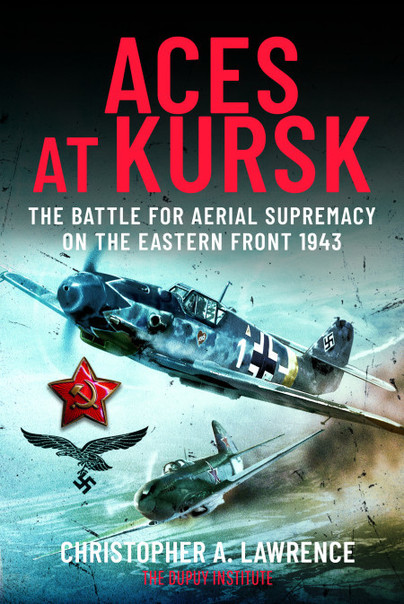Author guest post: Christopher A Lawrence
The Battle of Britain
versus
The Battle of Kursk
by
Christopher A. Lawrence
The Dupuy Institute
The Battle of Britain (13 August – 31 October 1940) is probably the most famous air battle in history. It certainly has had more books written about it than any other air battle, probably hundreds. It has been represented multiple times in film and documentaries.
The air battles that were part of the Battle of Kursk have a lot less written about them. In fact, my new book, Aces at Kursk, it only the fifth book focused on just this battle that I am aware of. Yet, it was a bigger air battle than the Battle of Britain.
The Battle of Kursk consists of four distinctly different parts. My book covers the German attack in the south exhaustively, and also discusses the air battle fought over the German attack in the north. The air campaigns in support of the subsequent two Soviet counteroffensives have yet to be addressed in detail. Each of these were an air campaign the size of the Battle of Britain.

In the south alone, 2,387 German sorties were flown by the VIII Air Corps on 5 July 1943. This is more sorties than flown on any single day of the Battle of Britain (13 August to 31 October 1940), although with fewer planes. The two opposing Soviet air armies flew 1,778 sorties, which was more than the British Air Force ever put up during any day of the Battle of Britain and more than the Germans flew on all but one day of that battle. The bloodiest day in the Battle of Britain, “Black Thursday” (15 August) when the Germans lost 75 aircraft and the British 34, was not near as bloody as the 5th of July 1943 in the south, when almost twice as many aircraft were lost (206 airplanes). The air fight in the southern part of the Kursk bulge was of the same scale as the far more famous Battle of Britain, while, at the same time, there was a similar size operation occurring in the north!
But, these are only two of the four parts that make up The Battle of Kursk. The first two parts were the offensive in the south conducted by the German Army Group South from 4 – 24 July 1943 and the smaller offensive in the north conducted by the German Ninth Army from 5 – 12 July 1943. The second part of the battle, which is even larger, is the Soviet counteroffensive on Orel conducted by multiple Soviet Army Groups that started on 12 July and the Soviet offensive against Kharkov conducted by multiple Soviet Army Groups that started on 3 August until the 23rd August 1943. Each of these have their own supporting air war.

Aces at Kursk examines the air actions leading up to the battle in July, and then covers in depth the entire German operations in support of German Army Group South from 4 to 24 July 1943 and covers the operations in the north until 12 July 1943. These operations included many of the top German and Russian aces and some of their most famous aviators. It was the first significant air battle on the Eastern Front since the Soviet Air Force had been gutted in the initial German onslaught of June of 1941. It was the first time the Soviet Air Force had attempted to contend with the German Air Force for control of the skies.
This was the last large air offensive the Luftwaffe staged over the battlefield area until the failed Operation Bodenplatte (Baseplate) offensive on 1 January 1945 that was launched during the Ardennes Campaign (Battle of the Bulge. In the south for 15 days from 4 July to 18 July, the Germans flew 15,857 sorties, or an average of 1,057 sorties a day. The two Soviet air armies flew 16,041 sorties into the Belgorod area or against the VIII Air Corps, or 1,069 sorties a day. That was 11,657 sorties by the Second Air Army and 4,384 sorties by the Seventeenth Air Army.
To again look at the Battle of Britain analogy, during the month of August 1940, the Germans flew only 4,779 sorties and dropped 4,636 tons of bombs. During the month of September 1940, the Germans flew 7,260 sorties and dropped 7,044 tons of bombs, and during the month of October 1940, the Germans flew 9,911 sorties and dropped 9,113 tons of bombs. Again, just looking at the operations in the south, the tonnage of bombs dropped at Kursk by the VIII Air Corps is not known. The Soviet Second Air Army reported that it dropped 1,244 tons of bombs and estimates that the Germans dropped 7,000 tons. Assuming the same proportion of delivered bombs to maximum bomb-carrying capacity, then we are looking at around 1,748.96 tons of bombs delivered by both the Second and Seventeenth Air Armies. In light of the total of 11,641 ground-attack type sorties flown by the Germans and only 4,295 ground-attack type sorties flown by the Soviets from the 4th through the 18th, the Soviet estimate of German bomb weight appears to be reasonable. Still, it would appear that the Soviet estimate of 7,000 tons of German bombs dropped may have been low and the actual figure could have been around 10,000 to 12,000 tons.
The overall daytime losses for this air campaign were 111 German planes and 660 Soviet planes (and a total of 667 Soviet planes lost). This lopsided 5.95-to-one exchange ratio is hard to explain, as the Soviets’ equipment was as good as the Germans’. It clearly shows the differences in training and experience between the two air forces. In light of the heavy losses the Soviet air force took, no one can question their bravery.

Aces at Kursk is available to order here.

